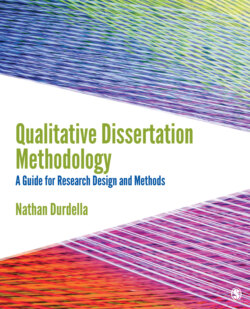Читать книгу Qualitative Dissertation Methodology - Nathan Durdella - Страница 67
На сайте Литреса книга снята с продажи.
Methodological details in qualitative inquiry.
ОглавлениеAlong the spectrum of qualitative and quantitative lines of inquiry, methodologies historically associated with qualitative research include phenomenology, ethnography, grounded theory, narrative inquiry, and case study—among others. While some researchers argue that case study does not qualify as a research methodology or may not be considered either a strictly qualitative or quantitative methodology, we can discuss case study as a specific approach to investigating a social phenomenon—and an approach that is especially well suited to applied dissertations. What these five qualitative approaches to inquiry have in common are the goals of research: discovery, description, verification, and interpretation (Ambert, Alder, Alder, & Detzner, 1995; Peshkin, 1993). What is more, all five methodologies offer opportunities for in-depth explorations of human social behavior. In Chapter 4, you can find more detailed discussions of qualitative methodologies and their application in dissertation contexts.
Whereas methodology relates to approaches to inquiry that include considerations for what matters and how to proceed, methods refer to the overall approach and specific procedures for gathering information in an investigation. That is, methods focus on how to generate data—information from research participants or subjects in an investigation—whereas procedures detail the specific steps that you will take to actually gather information. In this way, methods direct the procedural steps to identify, locate, and recruit people from whom you collect, analyze, and interpret information. Here, methods guide what researchers do in the field, office, or lab with the information that they have or gather. You can see key differences between methods and procedures in Table 2.1. The relationship between methodology and methods is one of direction: The methodological lens that researchers use informs overall approaches in data collection (methods) and step-by-step details in data collection (procedures) that they adopt. Indeed, the assumptions about what problems, questions, and information are valued prescribe ways to go about gathering and making sense of the information—they are embedded in the steps. As they say, the devil’s in the details—but more on this later in Chapter 6 and Chapter 7 with data collection and analysis!
In practical terms, methods tend to be classified by procedural steps—data collection and data analysis or information gathering and meaning making. Generally speaking, data collection methods in qualitative research include structured, semi-structured, and unstructured (i.e., ethnographic) interviews, observations, structured journals, critical incident reports, and document data collection. But what these procedural terms in the context of data collection tend to omit is the early steps in the process (really, the pre-fieldwork procedures): building rapport with gatekeepers and working with site staff and key players in research settings to invite, recruit, and secure research participants. More on these activities later—in Chapter 4 and Chapter 5—when research settings and data sources come into focus. In addition to methods of data collection, research methods include data analysis procedures that usually articulate how researchers make sense of the information that they gather. Generally speaking, researchers in qualitative studies detail analytical steps to move from raw data (e.g., digitally recorded audio interviews, observation field notes, digital document data, etc.) to patterned data or results of segmenting, coding, networking, thematizing, and interpreting data. Conventional analytical approaches in qualitative research include thematic data analysis—an overarching approach with procedural elements that tend to characterize steps across methodology- or discipline-specific approaches—constant-comparative method, narrative analysis, content analysis, and so on.
Table 2.1
When we consider research methodology and methods, we need to distinguish between these two terms and a commonly used term in qualitative research: research tradition. You are lucky here, if you identify as a qualitative researcher and use or will use qualitative research methodology in your dissertation! Why? Simple: You have another, distinctly qualitative term to describe your approach to inquiry: research tradition. While not universally accepted, I argue that research traditions are akin to research methodologies—explicitly articulating what is important to researchers, what they value in terms of problems, purposes, questions, and methods. According to Schram (2003, p. 66), research traditions are “rigorous, discipline-based carefully specified ways to conceptualize, describe, and analyze human social behavior and processes.” Indeed, Schram goes on to argue that research traditions have assumptions, principles, and procedures associated with them—much like research methodologies. Again, we are fortunate to have a seemingly organically derived term intimately connected to qualitative inquiry—it feels good—so you should feel free to adopt and use it interchangeably with methodology or exclusively in place of methodology in your dissertation.
